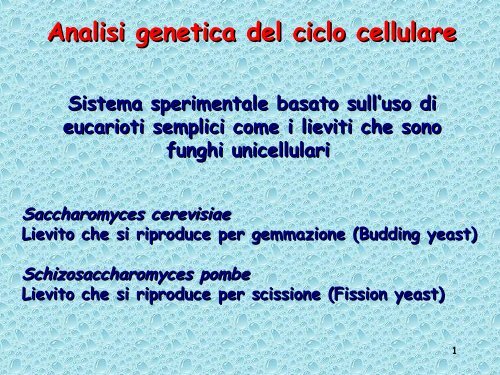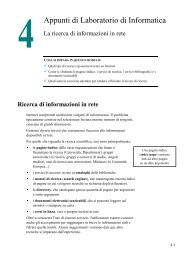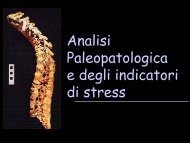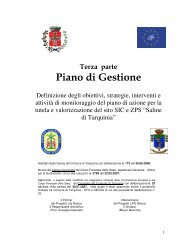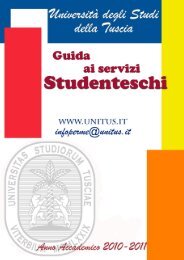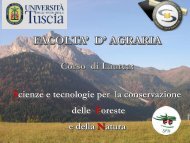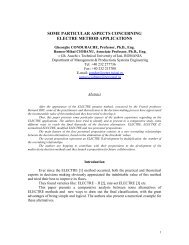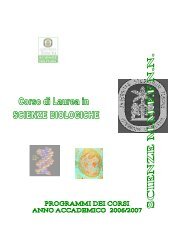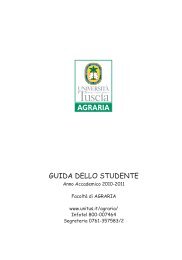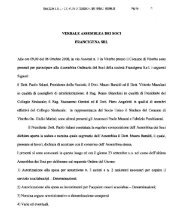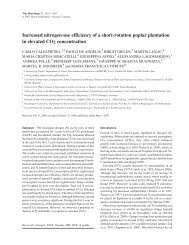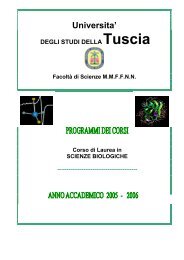Analisi genetica del ciclo cellulare - Università degli Studi della Tuscia
Analisi genetica del ciclo cellulare - Università degli Studi della Tuscia
Analisi genetica del ciclo cellulare - Università degli Studi della Tuscia
You also want an ePaper? Increase the reach of your titles
YUMPU automatically turns print PDFs into web optimized ePapers that Google loves.
<strong>Analisi</strong> <strong>genetica</strong> <strong>del</strong> <strong>ciclo</strong> <strong>cellulare</strong><br />
Sistema sperimentale basato sull’uso di<br />
eucarioti semplici come i lieviti che sono<br />
funghi unicellulari<br />
Saccharomyces cerevisiae<br />
Lievito che si riproduce per gemmazione (Budding yeast)<br />
Schizosaccharomyces pombe<br />
Lievito che si riproduce per scissione (Fission yeast)<br />
1
Schema <strong>del</strong> <strong>ciclo</strong> <strong>cellulare</strong> di S. cerevisiae<br />
Le cellule figlie al momento <strong>del</strong>la nascita sono più piccole <strong>del</strong>le<br />
cellule madri e devono crescere più a lungo in G1 prima di poter<br />
avere dimensioni compatibili con la successiva fase S<br />
2
Schema <strong>del</strong> <strong>ciclo</strong> <strong>cellulare</strong> di S. pombe<br />
Le cellule più lunghe sono in procinto di entrare in mitosi,<br />
mentre quelle più corte sono state appena prodotte dalla<br />
citocinesi<br />
3
Mancanza di nutrienti causa<br />
meiosi e sporulazione<br />
S. cerevisiae Proliferazione<br />
diploide<br />
Proliferazione<br />
aploide<br />
Coniugazione dopo la<br />
schiusa <strong>del</strong>le spore<br />
Mancanza di nutrienti causa<br />
coniugazione<br />
S. pombe Proliferazione<br />
aploide<br />
Proliferazione<br />
diploide<br />
Dopo la coniugazione si ha<br />
meiosi e sporulazione<br />
4
In organismi unicellulari la DIVISIONE CELLULARE<br />
coincide con la RIPRODUZIONE<br />
La mancanza di nutrienti potrebbe causare<br />
l’arresto <strong>del</strong> <strong>ciclo</strong> <strong>cellulare</strong>, ma i lieviti posseggono<br />
due meccanismi per impedire l’effetto letale <strong>del</strong>la<br />
mancanza di cibo:<br />
le cellule mantengono sempre una quantità<br />
minima di nutrienti necessaria per affrontare<br />
UNA replicazione, UNA mitosi e UNA divisione<br />
<strong>cellulare</strong>;<br />
le cellule reagiscono alla mancanza di nutrienti<br />
arrestando il <strong>ciclo</strong> <strong>cellulare</strong> in un punto preciso<br />
5
Due parametri regolano la proliferazione <strong>cellulare</strong>:<br />
✷Velocità di crescita (Vc)<br />
✷Velocità di divisione <strong>cellulare</strong> (Vd)<br />
Quando Vc = Vd le dimensioni cellulari rimangono<br />
costanti durante ogni <strong>ciclo</strong> <strong>cellulare</strong><br />
Quando o se Vc > Vd si producono cellule sempre più<br />
grandi ad ogni generazione<br />
Quando o se Vc < Vd si producono cellule sempre più<br />
piccole ad ogni <strong>ciclo</strong> di divisione<br />
Poiché il ritmo di crescita è regolato dall’ambiente esterno<br />
(nutrienti), la lunghezza <strong>del</strong> <strong>ciclo</strong> <strong>cellulare</strong> deve essere<br />
regolabile in maniera corrispondente<br />
6
Controllo <strong>del</strong>le dimensioni <strong>del</strong>la cellula tramite<br />
il controllo <strong>del</strong> <strong>ciclo</strong> <strong>cellulare</strong><br />
7
Yeast Size and Morphology Through the Cell Cycle<br />
8
Growth Regulation in Yeast<br />
Fission yeast grow in G1;<br />
- G2/M highly regulated<br />
Budding yeast grow in G1;<br />
- G1/S highly regulated<br />
S-phase regulation better understood in Budding yeast<br />
where G1/S more highly regulated than in Fission yeast<br />
9
Esistono dei punti di controllo <strong>del</strong>le dimensioni<br />
sia in G1 che in G2<br />
In S. cerevisiae il punto di controllo <strong>del</strong>la taglia in G1<br />
(START) è il più importante: se una cellula passa il<br />
punto di START supererà anche il punto di controllo in<br />
G2. G1 è sensibile all’ambiente esterno.<br />
In S. pombe il punto di controllo in G2 (INGRESSO<br />
MITOTICO) è il più selettivo per il controllo <strong>del</strong>le<br />
dimensioni. G2 è sensibile all’ambiente esterno.<br />
<br />
Nei mammiferi il punto di controllo fondamentale<br />
è in G1 ed è definito PUNTO DI RESTRIZIONE<br />
10
S. pombe cell cycle<br />
✸<br />
✸<br />
Mutants have been identified that are “stuck” at some point in this<br />
cycle (= cell division cycle, or cdc mutants).<br />
Such mutants are lethal, and are maintained as ts (temperature<br />
sensitive) alleles.<br />
11
I mutanti cdc possono essere selezionati solo<br />
se il loro fenotipo è CONDIZIONALE, cioè se<br />
il prodotto <strong>del</strong> gene smette di funzionare<br />
soltanto in certe condizioni.<br />
Di solito i mutanti condizionali sono<br />
TEMPERATURA-SENSIBILI (ts).<br />
Un ceppo cdc-ts cresce a bassa temperatura<br />
(CONDIZIONI PERMISSIVE) ) e non cresce<br />
più a temperatura alta (CONDIZIONI(<br />
NON<br />
PERMISSIVE).<br />
12
Both yeasts have been useful for the<br />
identification of cell division cycle<br />
(CDC) genes through conditionally lethal<br />
mutation<br />
CDC-ts mutants fail to cycle at restrictive<br />
temperature, , but they DO grow. This<br />
allows one to distinguish them from simple<br />
lethals.<br />
Like any other ts mutation, the wild-type<br />
allele at this locus can be cloned by<br />
complementation with a plasmid library<br />
13
Isolating Temperature Sensitive<br />
Mutants in Haploid Yeast<br />
14
Identificazione di mutanti<br />
cdc-ts di S. cerevisiae<br />
Isolamento <strong>del</strong> gene<br />
CDC-28 wild-type<br />
15
Alla temperatura permissiva il prodotto dei<br />
geni cdc viene sintetizzato<br />
Alla temperatura non permissiva (o restrittiva)<br />
il gene non viene espresso<br />
T. permissiva per S. cerevisiae 20-23 °C<br />
T. restrittiva per S. cerevisiae 35-37 °C<br />
16
Comportamento<br />
di un mutante<br />
cdc sensibile<br />
alla<br />
temperatura<br />
17
The Behavior of a Temperature Sensitive cdc Mutant<br />
cdc mutant growing<br />
at permissive temp (23°C)<br />
cdc mutant growth arrested<br />
after 6 hrs at non-permissive<br />
temp (36°C)<br />
18
Da S. pombe sono stati isolati due tipi di mutanti con<br />
difetti nei meccanismi di regolazione <strong>del</strong> <strong>ciclo</strong> <strong>cellulare</strong><br />
Tipo I<br />
Mutanti cdc che, alla t. permissiva, non riescono<br />
a passare attraverso una <strong>del</strong>le fasi <strong>del</strong> <strong>ciclo</strong><br />
<strong>cellulare</strong>; essi formano cellule più grandi che<br />
non sono capaci di dividersi<br />
mutante cdc 2 -<br />
19
Rappresentazione schematica dei fenotipi mutanti<br />
cdc 2 condizionali di S. pombe<br />
cdc 2 +<br />
cdc 2 -<br />
cdc 2 D<br />
20
Screening of cdc mutants with different<br />
phenotypes identified those that initiated<br />
mitosis early<br />
If mutations that block Mitosis are cdc2 (big)……<br />
…… mutations that initiate mitosis early will be small<br />
wild type<br />
wee1<br />
Probably Regulators<br />
of mitosis<br />
Screening for such mutants,<br />
discover of the wee<br />
mutants<br />
From Nurse (2002) ChemBioChem 3:596<br />
21
Da S. pombe sono stati isolati due tipi di mutanti con<br />
difetti nei meccanismi di regolazione <strong>del</strong> <strong>ciclo</strong> <strong>cellulare</strong><br />
Tipo II<br />
Mutanti wee che, alla t. permissiva, mancano <strong>del</strong>le<br />
proteine che normalmente impediscono alle cellule di<br />
dividersi se sono troppo piccole; essi formano cellule<br />
più piccole<br />
mutante wee 1<br />
22
Rappresentazione schematica dei fenotipi mutanti<br />
condizionali di S. pombe<br />
cdc 2 +<br />
cdc 2 -<br />
cdc 2 D<br />
wee 1<br />
23
La mutazione wee1 è recessiva ts<br />
Alla t. permissiva (25 °C) il mutante wee1 ha la taglia<br />
come il wild type<br />
Alla t. restrittiva (37 °C) il mutante wee1 ha la taglia<br />
ridotta<br />
La durata <strong>del</strong> <strong>ciclo</strong> <strong>cellulare</strong> a 25 °C e 37 °C è uguale?<br />
Le cellule <strong>del</strong> mutante wee1 sono più piccole perché il<br />
<strong>ciclo</strong> <strong>cellulare</strong> è più corto?<br />
24
Taglia minima richiesta per entrare in mitosi<br />
25
La mutazione wee1 influenza il <strong>ciclo</strong> <strong>cellulare</strong><br />
Quale è la funzione <strong>del</strong>la proteina Wee1?<br />
In quale momento <strong>del</strong> <strong>ciclo</strong> <strong>cellulare</strong> è necessaria<br />
la sua presenza?<br />
Quale è la transizione che viene inibita dalla<br />
proteina Wee1 mutante?<br />
La normale funzione <strong>del</strong>la proteina Wee1 è di<br />
ritardare l’ingresso in mitosi finchè le cellule non<br />
hanno raggiunto la taglia necessaria.<br />
Wee1 agisce come un meccanismo omeostatico che<br />
mantiene costante la taglia <strong>del</strong>le cellule.<br />
26
Mutanti di S. pombe che influenzano la taglia<br />
Ingresso normale in M<br />
Blocco ingresso in M<br />
Blocco ingresso in M<br />
Accellerazione ingresso in M<br />
Ingresso normale in M<br />
La funzione di Cdc25 è quella di “superare” la<br />
abilità di Wee1 di inibire l’ingresso in Mitosi<br />
Cdc25 e Wee1 hanno un effetto antagonistico<br />
27
La Mitosi viene indotta da un cambiamento<br />
<strong>del</strong>la quantità di Cdc2 o <strong>del</strong>la sua attività?<br />
Copie addizionali di Cdc2 e<br />
Cdc13 non influenzano il <strong>ciclo</strong><br />
E’ importante la ATTIVITA’<br />
piuttosto che la quantità<br />
Copie addizionali di Wee1<br />
causano un ritardo nell’ingresso<br />
in M. Copie addizionali di Cdc25<br />
anticipano M.<br />
E’ importante la QUANTITA’ di<br />
Cdc25 e di Wee1 piuttosto che<br />
la attività.<br />
28
Mutante cdc25 -<br />
Non entra in M<br />
(cellule lunghe)<br />
Mutante cdc25 D<br />
Prematuro ingresso in M<br />
(cellule piccole)<br />
La proteina Cdc25 stimola l’attività di MPF<br />
Mutante wee1 -<br />
Prematuro ingresso in M<br />
(cellule piccole)<br />
Mutante wee1 D<br />
Non entra in M<br />
(cellule lunghe)<br />
La proteina Wee1 inibisce l’attività di MPF<br />
29
attivatore<br />
inibitore<br />
30
The real power of yeast genetics<br />
emerged not from the identification of a<br />
mutant here and there, but from the<br />
possibility of getting multiple of alleles<br />
of any one gene<br />
Even then, CDC genetics was mostly an<br />
intellectual exercise until molecular<br />
biology made it possible to clone the<br />
genes, obtain their sequences, and<br />
purify the corresponding gene products<br />
31
Phosphorylation changes structure and<br />
function<br />
– phosphate group added by protein kinase<br />
– phosphate group removed by phosphatase<br />
Phosphorylation on:<br />
Ser, Thr and Tyr<br />
residues<br />
33
Why is phosphorylation such a<br />
common mechanism for regulating<br />
the activity of proteins?<br />
✼ Reversible<br />
✼ Large negative charge of<br />
phosphate group can cause<br />
major changes in protein<br />
structure that result in<br />
changes in function<br />
34
Phosphorylation<br />
Addition of phosphate group to protein<br />
Catalyzed by protein kinases<br />
Reversible (phosphate group removed by<br />
protein phosphatases)<br />
Regulates activity of protein<br />
Involved in cell signaling pathways<br />
Proteins can be phosphorylated at multiple<br />
sites<br />
35
Cdc2 was cloned and sequenced,<br />
revealing a Protein Kinase<br />
. . . .10 . . . .20 . . . .30 . . . .40 . . . .50 . . . .60 . . . .70 . . . .80 . . . .90 . . . 100<br />
Cdc2 1:---------------------------------MEN-YQKVEKIGEGTYGVVYKA---RHKLSGRIVAMKKIRLEDESEGVPSTAIREISLLKEVNDENN: 63<br />
Cdc28 1:-----------------------------MSGELAN-YKRLEKVGEGTYGVVYKALDLRPGQGQRVVALKKIRLESEDEGVPSTAIREISLLKELKDDN-: 69<br />
Kin28 1:-----------------------------MKVNME--YTKEKKVGEGTYAVVYLGCQ---HSTGRKIAIKEIKTSEFKDGLDMSAIREVKYLQEMQHPN-: 65<br />
Smk1 1:MNCTLTDNTRAINVASNLGAPQQRTIFAKERISIPGYYEIIQFLGKGAYGTVCSVKFKGRSPAAR-IAVKKISNIFNKEILLKRAIRELKFMNFFKGHKN: 99<br />
Hog1 1:----MTTNEEFI-----------RTQIFGTVFEITNRYNDLNPVGMGAFGLVCSATDTLTSQP---VAIKKIMKPFSTAVLAKRTYRELKLLKHLR-HEN: 81<br />
. . . 110 . . . 120 . . . 130 . . . 140 . . . 150 . . . 160 . . . 170 . . . 180 . . . 190 . . . 200<br />
Cdc2 64:RSNCVRLLDILHAES-KLYLVFEFLDMDLKKYMDRISETGATSLDPRLVQKFTYQLVNGVNFCHSRRIIHRDLKPQNLLIDKEGNLKLADFGLARSFGVP:162<br />
Cdc28 69:---IVRLYDIVHSDAHKLYLVFEFLDLDLKRYMEGIPKDQPLGAD--IVKKFMMQLCKGIAYCHSHRILHRDLKPQNLLINKDGNLKLGDFGLARAFGVP:164<br />
Kin28 65:---VIELIDIFMAYDN-LNLVLEFLPTDL----EVVIKDKSILFTPADIKAWMLMTLRGVYHCHRNFILHRDLKPNNLLFSPDGQIKVADFGLARAIPAP:157<br />
Smk1 100:IVNLIDLEIVTSSPYDGLYCYQELIDYDLAKVIH-----SSVQLSEFHIKYFLYQILCGLKYIHSADVIHRDLKPGNILCTLNGCLKICDFGLARGIHAG:194<br />
Hog1 82:LICLQDIFL---SPLEDIYFVTELQGTDLHRLLQ-----TRPLEKQF-VQYFLYQILRGLKYVHSAGVIHRDLKPSNILINENCDLKICDFGLAR-----:167<br />
. . . 210 . . . 220 . . . 230 . . . 240 . . . 250 . . . 260 . . . 270 . . . 280 . . . 290 . . . 300<br />
Cdc2 163:LRN---------YTHEIVTLWYRAPEVLLGSRHYSTGVDIWSVGCIFAEMIRRSPLFPGDSEIDEIFKIFQVLGTPNEEVWPGVTLLQDYKST-----FP:248<br />
Cdc28 165:LRA---------YTHEIVTLWYRAPEVLLGGKQYSTGVDTWSIGCIFAEMCNRKPIFSGDSEIDQIFKIFRVLGTPNEAIWPDIVYLPDFKPS-----FP:250<br />
Kin28 158:HEI---------LTSNVVTRWYRAPELLFGAKHYTSAIDIWSVGVIFAELMLRIPYLPGQNDVDQMEVTFRALGTPTDRDWPEVSSFMTYNKLQI---YP:245<br />
Smk1 195:FFKCHSTVQ-PHITNYVATRWYRAPELLLSNQPYSKSVDIWAVGCILAEFYARKPVFMGRDSMHQIFEIIKVLGTPDKDILIKFGTIKAWNLGK-NSNNP:292<br />
Hog1 167:-------IQDPQMTGYVSTRYYRAPEIMLTWQKYDVEVDIWSAGCIFAEMIEGKPLFPGKDHVHQFSIITDLLGSPPKDVI---NTICSENTLKFVTSLP:257<br />
. . . 310 . . . 320 . . . 330 . . . 340 . . . 350 . . . 360 . . . 370 . . . 380 . . . 390 . . . 400<br />
Cdc2 249:RWKRMDLHKVVPNGEEDAIELLSAMLVYDPAHRISAKRALQQNYLRDFH---------------------------------------------------:297<br />
Cdc28 251:QWRRKDLSQVVPSLDPRGIDLLDKLLAYDPINRISARRAAIHPYFQES----------------------------------------------------:298<br />
Kin28 246:PPSRDELRKRFIAASEYALDFMCGMLTMNPQKRWTAVQCLESDYFKELPPPSD-PSSIKIRN--------------------------------------:306<br />
Smk1 293:VYKKIPWSNIFPFASHEAINLIESLLHWDSTHRLNVEQAISHPFLNEVRKPDDEPVCLQGPFDFTYESELNSMSKLRDYLVEEVKNFKTDLSSSSL----:388<br />
Hog1 258:HRDPIPFSERFKTVEPDAVDLLEKMLVFDPKKRITAADALAHPYSAPYHDPTDEPVA-DAKFDWHFNDADLPVDTWRVMMYSEILDFHKIGGSDGQIDIS:356<br />
. . . 410 . . . 420 . . . 430 . . . 440 . . . 450 . . . 460 . . . 470 . . . .<br />
Cdc2 :-------------------------------------------------------------------------------:<br />
Cdc28 :-------------------------------------------------------------------------------:<br />
Kin28 :-------------------------------------------------------------------------------:<br />
Smk1 :-------------------------------------------------------------------------------:<br />
Hog1 357:ATFDDQVAAATAAAAQAQAQAQAQVQLNMAAHSHNGAGTTGNDHSDIAGGNKVSDHVAANDTITDYGNQAIQYANEFQQ:435<br />
36
Cdc28 is the Budding Yeast Cdc2 Homologue<br />
- Cdc28 regulates entry into S-phase and mitosis<br />
- Cdc28 is a protein kinase that complements cdc2 ts<br />
Cdc28 is 63% Identical to Cdc2<br />
. . . .10 . . . .20 . . . .30 . . . .40 . . . .50 . . . .60 . . . .70 . . . .80 . . . .90 . . . 100<br />
Cdc28 1:MSGELANYKRLEKVGEGTYGVVYKALDLRPGQGQRVVALKKIRLESEDEGVPSTAIREISLLKELKDDN----IVRLYDIVHSDAHKLYLVFEFLDLDLK: 96<br />
Cdc2 1:----MENYQKVEKIGEGTYGVVYKARHKLSG---RIVAMKKIRLEDESEGVPSTAIREISLLKEVNDENNRSNCVRLLDILHAES-KLYLVFEFLDMDLK: 92<br />
. . . 110 . . . 120 . . . 130 . . . 140 . . . 150 . . . 160 . . . 170 . . . 180 . . . 190 . . . 200<br />
Cdc28 97:RYMEGIPKD--QPLGADIVKKFMMQLCKGIAYCHSHRILHRDLKPQNLLINKDGNLKLGDFGLARAFGVPLRAYTHEIVTLWYRAPEVLLGGKQYSTGVD:194<br />
Cdc2 93:KYMDRISETGATSLDPRLVQKFTYQLVNGVNFCHSRRIIHRDLKPQNLLIDKEGNLKLADFGLARSFGVPLRNYTHEIVTLWYRAPEVLLGSRHYSTGVD:192<br />
. . . 210 . . . 220 . . . 230 . . . 240 . . . 250 . . . 260 . . . 270 . . . 280 . . . 290 . . . 300<br />
Cdc28 195:TWSIGCIFAEMCNRKPIFSGDSEIDQIFKIFRVLGTPNEAIWPDIVYLPDFKPSFPQWRRKDLSQVVPSLDPRGIDLLDKLLAYDPINRISARRAAIHPY:294<br />
Cdc2 193:IWSVGCIFAEMIRRSPLFPGDSEIDEIFKIFQVLGTPNEEVWPGVTLLQDYKSTFPRWKRMDLHKVVPNGEEDAIELLSAMLVYDPAHRISAKRALQQNY:292<br />
. .<br />
Cdc28 295:FQES-:298<br />
Cdc2 293:LRDFH:297<br />
37
Limited biochemistry confirmed<br />
that Cdc2 is a Protein Kinase<br />
Functional characterization:<br />
- Cdc2 immunoprecipitates have kinase activity<br />
- this kinase activity peaks at G2/M<br />
- the kinase activity from cdc2 ts lysates<br />
disappears at high temperature<br />
<strong>Studi</strong>es of genetic interactions suggested, however,<br />
that Cdc2 did not function alone: Cdc13 mutations<br />
had just the same phenotype as Cdc2, and mild<br />
alleles of the two genes were additive, an example<br />
of a “synthetic genetic interaction.”<br />
38
Cloning and sequencing of Cdc13<br />
showed that it was a cyclin<br />
Cdc13 functions at the same time in mitosis as Cdc2<br />
- Cdc13 required for Cdc2 function<br />
CDC13 Cloning reveals that Cdc13 is a Cyclin<br />
- Homology to Starfish Cyclin B (Tim Hunt)<br />
- Cdc13 protein levels cycle<br />
- correspond with Cdc2 activity<br />
- Cdc13 is required for Cdc2 function in-vitro and in-vivo<br />
Nurse and collaborators propose that Cdc2 is<br />
Cyclin-Dependent Kinase, but clarifying this<br />
with authority required biochemistry.<br />
39
Cyclins<br />
Regulatory subunits of Cdk (cyclindependent<br />
kinase) complexes<br />
(heterodimeric protein kinases)<br />
Turn on kinase activity<br />
(phosphorylation)<br />
Levels vary cyclically during cell<br />
cycle<br />
Degraded by proteolysis at specific<br />
points in the cell cycle<br />
40
Cdk (cyclin-dependent kinase)<br />
complexes<br />
• Heterodimeric (two different subunits)<br />
protein kinases that regulate cell cycle<br />
– Cyclin: regulatory subunit<br />
– Cdk (cyclin-dependent kinase): catalytic subunit<br />
• Phosphorylate proteins<br />
involved in cell cycle<br />
• Different Cdk complexes<br />
for different cell-cycle<br />
phases (G 1<br />
, S, M)<br />
41
La fosfatasi Cdc25 ha una azione<br />
ATTIVATRICE su MPF<br />
La chinasi Wee1 ha una azione<br />
INIBITRICE su MPF<br />
Ulteriori studi hanno rivelato che la Cdc25<br />
è una FOSFATASI e che la Wee1 è una<br />
CHINASI<br />
42
Regolazione <strong>del</strong>la attività di MPF di S. pombe<br />
MPF<br />
Wee1<br />
CAK<br />
Cdc25<br />
Cdc13/Cdc2 (ciclinaB/CDK)<br />
chinasi<br />
(effetto inibitorio)<br />
chinasi<br />
(effetto attivatorio)<br />
fosfatasi<br />
(effetto attivatorio)<br />
44
Le attività di Cdc25 e di Wee1 sono regolate<br />
durante il <strong>ciclo</strong> <strong>cellulare</strong><br />
INTERFASE<br />
bassa [Cdc25]<br />
alta [Wee1]<br />
bassa [Wee1]<br />
alta [Cdc25]<br />
MITOSI<br />
45
Ruolo <strong>del</strong> residuo di Tyr 15 fosforilato dalla Wee1<br />
N<br />
15<br />
T Y G<br />
C<br />
Cdc2 +<br />
mutagenesi sito-specifica<br />
N<br />
T F G<br />
C<br />
Cdc2-F15Y<br />
I mutanti Cdc2-F15Y hanno fenotipo wee<br />
MPF è sempre attivo<br />
Prematuro ingresso in Mitosi<br />
46
Struttura <strong>del</strong>la Cdk2 umana, omologa alla subunità<br />
Cdc2 di MPF<br />
Zona di contatto<br />
con la ciclina in<br />
giallo<br />
Il T loop contiene<br />
Thr stimolatoria<br />
(T160)<br />
ATP<br />
rappresentato con<br />
sfere<br />
47
Complesso Cdk2-ciclina A non fosforilato<br />
(bassa attività)<br />
Il legame <strong>del</strong>la<br />
ciclina A provoca<br />
uno spostamento<br />
<strong>del</strong> T loop che,<br />
però, non<br />
consente la<br />
completa attività<br />
chinasica<br />
48
Complesso Cdk2-ciclina A fosforilato (elevata<br />
attività)<br />
La fosforilazione<br />
<strong>del</strong>la Thr<br />
stimolatoria<br />
aumenta la<br />
affinità dei<br />
substrati proteici<br />
da fosforilare<br />
49
Basi strutturali <strong>del</strong>l’attivazione <strong>del</strong>la Cdk<br />
50
Il modo in cui una Cdk agisce da<br />
integratore di segnali<br />
CAK attivatrice<br />
Sito di attivazione<br />
(Thr 161)<br />
Cdc25 attivatrice<br />
Sito di inibizione<br />
(Tyr 15)<br />
Wee1 inibitrice<br />
51
Budding Yeast Saccharomyces cerevisiae<br />
<br />
<br />
Mutants have been identified that are “stuck” at some point in this<br />
cycle (= cell division cycle, or cdc mutants).<br />
Such mutants are lethal, and are maintained as ts (temperature<br />
sensitive) alleles.<br />
52
Mutanti cdc di S.cerevisiae<br />
T. permissiva = 20-23 °C<br />
T. restrittiva = 35-37 °C<br />
Alla temperatura non<br />
permissiva solo i mutanti cdc si<br />
arrestano sempre allo stesso<br />
punto <strong>del</strong> <strong>ciclo</strong> <strong>cellulare</strong><br />
Mutante cdc28 ts di S. cerevisiae<br />
Omologo di cdc2 ts di S. pombe<br />
53
Dimostrazione sperimentale <strong>del</strong> punto di<br />
START in S. cerevisiae<br />
54
INTERFASE PRECOCE DI S. CEREVISIAE<br />
Inizia la sintesi di DNA<br />
Si forma la gemma<br />
Si duplica il corpo <strong>del</strong> fuso polare<br />
cdc7 ts<br />
cdc24 ts<br />
cdc31 ts<br />
Mutanti che non iniziano la sintesi di<br />
DNA alla T. restrittiva<br />
Mutanti che non formano la gemma<br />
alla T. restrittiva<br />
Mutanti che non duplicano il corpo <strong>del</strong><br />
fuso polare alla T. restrittiva<br />
cdc28 ts<br />
Mutanti che alla T. restrittiva<br />
bloccano TUTTI gli eventi a valle<br />
55
Mappa logica <strong>del</strong> <strong>ciclo</strong> <strong>cellulare</strong> di S. cerevisiae<br />
56
I mutanti cdc7 ts ,<br />
cdc24 ts<br />
e cdc31 ts<br />
bloccano eventi a valle<br />
individuali<br />
cdc28 ts è un<br />
componente chiave <strong>del</strong><br />
macchinario <strong>del</strong> <strong>ciclo</strong><br />
<strong>cellulare</strong><br />
57
La scoperta <strong>del</strong> mutante cdc28 ts<br />
di S.<br />
cerevisiae ha consentito di definire il punto<br />
di START:<br />
Lo START viene definito come il momento in cui<br />
la replicazione <strong>del</strong> DNA, la formazione <strong>del</strong>la<br />
gemma e la duplicazione <strong>del</strong> corpo <strong>del</strong> fuso polare<br />
diventano insensibili alla perdita di funzione di<br />
Cdc28;<br />
Il punto di START rappresenta la fine di un<br />
processo che impegna irreversibilmente le cellule<br />
a replicare il proprio DNA;<br />
Quando le cellule oltrepassano il punto di START<br />
sono irrevocabilmente destinate ad entrare in S<br />
58
Cellule che completano un <strong>ciclo</strong> <strong>cellulare</strong> in un tempo<br />
inferiore a quello richiesto per raddoppiare la propria<br />
taglia diventerebbero progressivamente sempre più piccole<br />
Tutte le cellule eucariotiche replicano il proprio DNA e<br />
segregano i cromosomi in tempi inferiori a quelli richiesti per<br />
raddoppiare le proprie dimensioni<br />
Si impiega meno tempo a completare un <strong>ciclo</strong> di divisione<br />
<strong>cellulare</strong> che a raddoppiare le dimensioni cellulari<br />
59
Nel lievito S. cerevisiae la divisione produce due<br />
cellule figlie di dimensioni differenti. Se fosse<br />
necessario SOLO raddoppiare la taglia per poter<br />
andare incontro ad un altro <strong>ciclo</strong> di divisione <strong>cellulare</strong><br />
si avrebbero <strong>degli</strong> effetti catastrofici!!<br />
60
La crescita <strong>cellulare</strong> e il <strong>ciclo</strong> di divisione<br />
<strong>cellulare</strong> sono coordinati<br />
La cellula figlia deve<br />
crescere più <strong>del</strong>la cellula<br />
madre per arrivare alla<br />
taglia critica necessaria<br />
per passare attraverso il<br />
punto di START, quindi<br />
l’intervallo G1 è più<br />
lungo<br />
61
I lieviti che si riproducono per gemmazione usano<br />
il punto di START come punto di controllo <strong>del</strong>le<br />
dimensioni e <strong>del</strong>le condizioni esterne. Cosa succede<br />
se mancano i nutrienti?<br />
Le cellule mantengono sempre una quantità<br />
di minima di nutrienti sufficiente per<br />
affrontare UNA replicazione, UNA mitosi<br />
ed UNA divisione <strong>cellulare</strong>;<br />
Le cellule reagiscono alla mancanza di<br />
nutrienti arrestando il <strong>ciclo</strong> <strong>cellulare</strong> in un<br />
punto preciso<br />
62
Destino alternativo di S. cerevisiae in<br />
prossimità <strong>del</strong> punto di START<br />
63
La scoperta <strong>del</strong> mutante cdc28 ts<br />
di S.<br />
cerevisiae ha consentito di definire il punto<br />
in cui le cellule si bloccano e verificano se<br />
ci sono tutte le condizioni per passare<br />
attraverso il punto di START.<br />
Lo studio <strong>del</strong>la coniugazione di cellule<br />
aploidi di S. cerevisiae ha consentito di<br />
chiarire quali sono i fattori in grado di<br />
“regolare” il passaggio attraverso il punto<br />
di START<br />
64
Le cellule aploidi di lievito<br />
producono fattori di<br />
accoppiamento (feromoni) e<br />
i loro recettori<br />
In presenza di una<br />
quantità sufficiente di<br />
nutrienti le cellule si<br />
moltiplicano come diploidi,<br />
ma in loro assenza sono<br />
indotte alla meiosi<br />
65
Accoppiamento nel budding yeast<br />
Affinchè avvenga la coniugazione è necessario:<br />
Che le due cellule aploidi siano di “tipo” differente<br />
Che le due cellule si trovino nella stessa fase <strong>del</strong><br />
<strong>ciclo</strong> <strong>cellulare</strong> (G1)<br />
66
Quando i feromoni a e α legano i rispettivi<br />
recettori attivano una trasduzione <strong>del</strong> segnale<br />
intra<strong>cellulare</strong> che prevede due differenti strade:<br />
Arresto <strong>del</strong> <strong>ciclo</strong> <strong>cellulare</strong> allo START<br />
Espressione di geni coinvolti nel processo<br />
<strong>del</strong>l’accoppiamento<br />
Questo meccanismo consente la coniugazione<br />
solo alle cellule che sicuramente hanno già<br />
duplicato correttamente il proprio DNA e che<br />
sono in “sosta” allo START<br />
67
PATHWAY DI SEGNALAZIONE<br />
feromoni a o α legati<br />
ai rispettivi recettori<br />
Arresto in G1<br />
(prima <strong>del</strong>lo START)<br />
Attivazione di geni di<br />
accoppiamento<br />
68
I mutanti resistenti<br />
all’accoppiamento possono<br />
essere distinti in due gruppi:<br />
MUTANTI ARRESTO-DIFETTIVI<br />
MUTANTI DI SEGNALAZIONE<br />
69
Regulation of G1/S transition (start/restriction point)<br />
Identification of yeast G1 cyclin<br />
Genetic screen: add α-mating factor to yeast culture<br />
Screen for ts mutants that continue to grow at 37 o C<br />
in presence of α-mating factor<br />
CLN3 mutant: unable to respond to α-mating factor<br />
mutant cells smaller than wild type<br />
CLN3 cloned: weakly homologues to CyclinB<br />
Levels of CLN3 affect ability of yeast to pass START<br />
70
Dosage effect of CLN3<br />
La selezione di mutanti<br />
arresto-difettivi<br />
ha<br />
portato all’isolamento<br />
<strong>del</strong> gene CLN3<br />
∆ cln3 indica assenza <strong>del</strong><br />
gene<br />
CLN3-1 D indica il mutante<br />
in cui è presente una<br />
<strong>del</strong>ezione al C-ter che<br />
stabilizza la proteina<br />
71
N<br />
C<br />
Cicline mitotiche<br />
N<br />
C<br />
Cicline G1<br />
Box di distruzione riconosciuto dalla ubiquitina<br />
Box di distruzione: sequenza PEST<br />
Regione di elevata omologia fra le cicline<br />
72
La ricerca di<br />
mutanti capaci di<br />
sopperire alcune<br />
mutazioni cdc28 ts<br />
ha portato<br />
all’isolamento di<br />
altre cicline G1<br />
CLN1 e CLN2<br />
73
Dimostrazione che le cicline G1 regolano<br />
l’ingresso in S in S. cerevisiae<br />
✥ Delezione dei geni codificanti per le cicline G1 (CLN1,<br />
2, 3)<br />
✥ Trasformazione <strong>del</strong>le cellule prive di CLN1, 2 e 3<br />
con vettore di espressione in cui CLN3 è sotto il<br />
controllo <strong>del</strong> promotore forte GAL1 (inibito da<br />
glucosio)<br />
✥ Inibizione <strong>del</strong>la espressione di CLN3 in presenza di<br />
glucosio<br />
✥ Espressione di CLN3 in assenza di glucosio<br />
74
Proof that G1 Cyclins control Start<br />
Inducible Cln3:<br />
To examine cell cycle state:<br />
stain with DNA dye<br />
pass through fluorescence-activated cell<br />
sorter<br />
2 peaks: G1 cells (1N) and G2 cells (2N)<br />
75
Il prodotto<br />
dei geni<br />
CLN1, 2 e 3 è<br />
indispensabile<br />
per passare<br />
attraverso il<br />
punto di<br />
START<br />
76
Le cicline CLN1, 2 e 3<br />
sono intercambiabili<br />
C’è bisogno almeno di<br />
una ciclina G1 per<br />
passare attraverso il<br />
punto di START<br />
77
Regolazione <strong>del</strong>le cicline G1<br />
Loop di feedback positivo che prevede sia attivazione<br />
post-trascrizionale che post-traduzionale<br />
78
Destino alternativo di S. cerevisiae in<br />
prossimità <strong>del</strong> punto di START<br />
79
La attivazione di proteine G da parte dei<br />
feromoni porta all’arresto <strong>del</strong> <strong>ciclo</strong> <strong>cellulare</strong><br />
Il pathway di segnalazione è molto complesso<br />
e richiede molti componenti<br />
Il pathway di segnalazione mediato da<br />
feromoni in S. cerevisiae è molto simile a<br />
quello <strong>del</strong>le cellule di mammifero che è<br />
mediato da fattori di crescita<br />
I feromoni e i fattori di crescita regolano la<br />
stessa transizione G1/S<br />
80
MECCANISMI DI SEGNALAZIONE<br />
81
Attivazione mediata da proteine G trimeriche<br />
82
cAMP:<br />
secondo<br />
messaggero<br />
83
IP3 e DAG: secondi messaggeri<br />
85
Via di<br />
segnalazione<br />
mediata da<br />
Ras<br />
87
Sinergia fra vie di trasduzione <strong>del</strong> segnale<br />
88
Cascata di proteine chinasi che trasmette segnali a valle di<br />
proteine G trimeriche nella via di segnalazione mediata da<br />
feromoni in S. cerevisiae<br />
89
Fattore di accoppiamento<br />
Attivazione Prot. G trimerica<br />
Attivazione cascata di Chinasi<br />
Fus3<br />
Fus3-P<br />
Far1<br />
Far1-P<br />
Ste12<br />
Ste12-P<br />
Stop allo START<br />
Trascrizione geni<br />
per accoppiamento<br />
90
Differenti pathways di segnalazione a confronto<br />
92
La mancanza di nutrienti causa l’arresto<br />
in G0<br />
Selezione di mutanti che presentano<br />
difetti nel meccanismo di monitoraggio<br />
<strong>del</strong>la disponibilità di nutrienti<br />
Questi mutanti bloccano il passaggio<br />
attraverso lo START alla T. non<br />
permissiva e si comportano come se le<br />
cellule si trovassero in carenza di<br />
nutrienti<br />
93
Isolamento <strong>del</strong> mutante cdc35 ts<br />
cdc35 + è la<br />
adenilato ciclasi che<br />
Il prodotto di cdc35<br />
catalizza la formazione di AMP<br />
ciclico a partire dall’ATP<br />
L’AMP ciclico attiva la chinasi<br />
dipendente da cAMP<br />
94
Mutazioni di cdc35 + causano un abbassamento dei<br />
livelli di cAMP e quindi una riduzione <strong>del</strong>la attività<br />
<strong>del</strong>la chinasi cAMP-dipendente.<br />
Una minore attività <strong>del</strong>la chinasi cAMP-dipendente<br />
causa una diminuzione <strong>del</strong>la velocità di sintesi proteica<br />
La velocità di sintesi <strong>del</strong>le cicline G1<br />
determina la possibilità o meno di passare<br />
attraverso il punto di START<br />
95
La attività <strong>del</strong>la adenilato ciclasi Cdc35 + è<br />
regolata da Ras (p 21 Ras)<br />
96
Small GTP-binding proteins: active in the GTP-bound form<br />
1. Intrinsic GTPase activity is poor<br />
2. The catalytic cycle is regulated by other proteins:<br />
GEFs (Guanine nucleotide exchange factors)<br />
and<br />
GAPs (GTPase-activating proteins)<br />
Stimulated by GAP<br />
Stimulated by GEF<br />
97
La attività di Ras (p 21 Ras)<br />
è regolata da Cdc25 +<br />
Il prodotto di cdc25 + è la<br />
proteina che scambia<br />
nucleotidi guanilici (GEF).<br />
Mutanti cdc25 ts si bloccano<br />
allo START (G0) perché Ras<br />
si accumula nella sua forma<br />
inattiva Ras-GDP<br />
98
La attività di Cdc35 + è regolata da Ras<br />
(p 21 Ras)<br />
Velocità <strong>del</strong>la<br />
sintesi proteica OK<br />
La capacità <strong>del</strong>le cellule<br />
di arrestare il <strong>ciclo</strong><br />
<strong>cellulare</strong> in mancanza di<br />
nutrienti è controllata<br />
dalla attività di almeno<br />
due proteine (cdc25<br />
+ e<br />
cdc35 + )<br />
Cicline G1<br />
Crescita OK<br />
99
Pathway di segnalazione mediato dalla<br />
mancanza di nutrienti (arresto in G0)<br />
Cdc25<br />
(proteina che scambia nucleotidi guanilici)<br />
p21Ras-GTP<br />
(Proteina G monomerica)<br />
Cdc35<br />
(adenilato ciclasi)<br />
ATP cAMP Chinasi cAMP-dipendente<br />
Effetto sulla velocità <strong>del</strong>la sintesi<br />
proteica<br />
Sintesi cicline G1 OK<br />
Crescita e progressione <strong>del</strong> <strong>ciclo</strong> <strong>cellulare</strong><br />
Crescita e progressione <strong>del</strong> <strong>ciclo</strong> <strong>cellulare</strong><br />
100
Destino di S. cerevisiae durante la<br />
transizione G1/S<br />
Arresto in G0<br />
G1<br />
Arresto in G1<br />
Sporulazione (cellule diploidi)<br />
Accoppiamento (cellule aploidi)<br />
101


